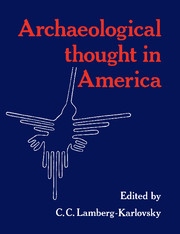Book contents
- Frontmatter
- Contents
- List of illustrations
- Introduction
- Part I History, method, and theory
- 1 History and contemporary American archaeology: a critical analysis
- 2 Aspects of the application of evolutionary theory in archaeology
- 3 The “New Archaeology,” then and now
- 4 Marxism in American archaeology
- 5 Formal approaches in archaeology
- 6 Ideology and evolutionism in American archaeology: looking beyond the economic base
- 7 The present and the future of hunter-gatherer studies
- 8 Paleopathology and the interpretation of economic change in prehistory
- Part II Archaeology in the Americas and beyond
- References
- Index
8 - Paleopathology and the interpretation of economic change in prehistory
Published online by Cambridge University Press: 06 July 2010
- Frontmatter
- Contents
- List of illustrations
- Introduction
- Part I History, method, and theory
- 1 History and contemporary American archaeology: a critical analysis
- 2 Aspects of the application of evolutionary theory in archaeology
- 3 The “New Archaeology,” then and now
- 4 Marxism in American archaeology
- 5 Formal approaches in archaeology
- 6 Ideology and evolutionism in American archaeology: looking beyond the economic base
- 7 The present and the future of hunter-gatherer studies
- 8 Paleopathology and the interpretation of economic change in prehistory
- Part II Archaeology in the Americas and beyond
- References
- Index
Summary
One of the most important trends in archaeology in the 1980s has been the emergence of human osteology and paleopathology as means of testing hitherto untested (and often, supposedly “untestable”) theories about the meaning of prehistoric events. A number of controversies about prehistory are now (at least potentially) amenable to resolution because opposing theories explicitly or implicitly offer conflicting predictions about changes in human health and nutrition.
The emerging importance of these new lines of inquiry is based in part on an explosive increase in the attention paid to human remains from archaeological sites and in part on significant changes which have occurred in the style of paleopathological research. Despite the work of some early pioneers, much of the work in paleopathology prior to the last decade focused on the diagnosis and description of specific examples of pathological conditions in individual skeletons. Early workers in the field were medical specialists often lacking sophistication about social issues. Much of what they reported was of little more than anecdotal value to other prehistorians. The tendency of pathologists to focus on rare diseases and spectacular examples of illness resulted in diagnoses which proved the antiquity of certain types of illness, but told us little about the relationship of health and disease to surrounding economic and social conditions.
- Type
- Chapter
- Information
- Archaeological Thought in America , pp. 117 - 132Publisher: Cambridge University PressPrint publication year: 1989
- 6
- Cited by



